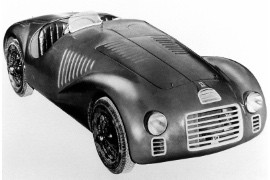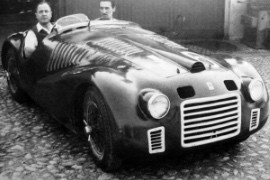FERRARI 125/159 S Models/Series Timeline, Specifications & Photos
First production year: 1947
Engines: Gasoline
Body style: Convertible (spider/spyder, cabrio/cabriolet, drop/open/soft top)
This car started everything in Maranello, from a factory that was bombed in WWII. A car which was the foundation for one of the greatest sports cars in history: the 1947 Ferrari 125 and the racing sibling, the 125 S.
In the brinks of WWII, Enzo Ferrari was ready to start the car production, but he had an agreement with his former employer, Alfa Romeo, to not put his name on a car for 5 years so he built the Auto Avio Costruzioni 815 in 1940. Then everything was stopped by the war. In 1944 and 1945, the factory was bombed three times. Enzo Ferrari and his workers survived and, as soon as the peace was installed, they started to work on a new car.
The desire for sports cars didn't stop Enzo. In 1947, the world was struggling to recover and most car-makers started to work on economic models. But no, Enzo built the 125. He used its experience in motor racing and in the production of the Avio 815. The bodywork was an open-top roadster with two seats.
The car featured the same wheelbases as the Avio Costrizioni but with an independent front suspension with unequal double wishbone arms and a transverse leaf-spring. In the rear, there was a live axle with semi-elliptic springs, dampers and anti-roll bar.
Under the hood. the engine had the same 1.5-liter displacement as the Avio 815, but it was completely new. It was a V12 unit that boasted almost 80 hp/liter without the aid of any turbocharger. That was a very high value for those times. He could only build two cars: a 125 and a 125 S. The latter raced two weeks after it was manufactured and it lost due to a failure of the fuel pump.
After the successful Ferrari 125 S on the race tracks, the Italian car manufacturer went even further and created the 159 S, which was an evolution of its predecessor.
Built to win races, the 159 S was produced in just two units, just like the 125 S. But there were a few details that distinguished the two models one from the other. The car didn't just have a bigger, more powerful engine. It also sported a different bodywork, albeit it relied on the same chassis.
Gioacchino Colombo was, again, responsible for designing the new model, just like the previous model. Yet, he noticed that the car needed a wider bodywork with the wheels completely covered by fenders so the driver won't get hit by dirt and small stone thrown by the front tires. While it enlarged the front fascia, Colombo also added additional air intakes in front of the car, flanking the main grille to cool the brakes. In addition, the engine compartment received more vents on the sides, behind the fenders, that extracted the heat produced by the engine. The manufacturer also noticed that the doors were not needed for such a roadster, so the 159 S didn't have any.
The cockpit could accommodate two occupants: the driver and the helper. In long-distance races, the navigator was essential for winning races. When raced on closed circuits, though, the car sported only one seat, thus reducing the vehicle's weight. The 159 S was designed and built as a race car, and the main dial on the dashboard was the tachometer placed right in front of the driver.
Colombo modified the engine from the 125 S and increased its bore and stroke, resulting in a 2-liter V12 engine. It was fed by three Webber-32DCF and produced seven more ponies than its predecessor. There were only two vehicles produced, and later on, a 159 S was transformed and evolved into the 166 S that raced at the famous Mille Miglia in Italy.

